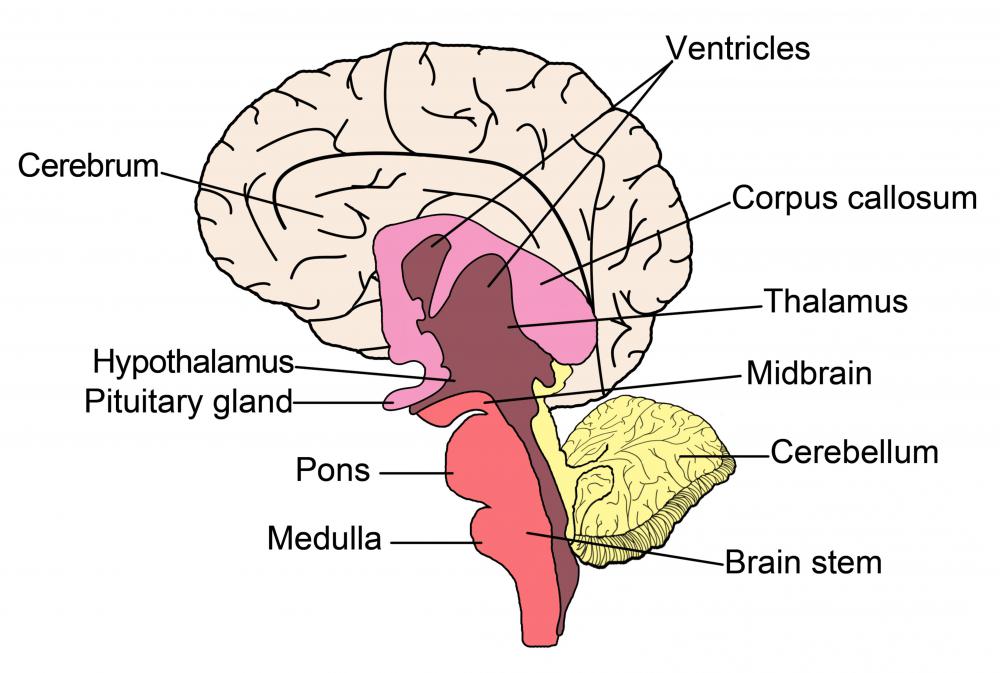At WiseGEEK, we're committed to delivering accurate, trustworthy information. Our expert-authored content is rigorously fact-checked and sourced from credible authorities. Discover how we uphold the highest standards in providing you with reliable knowledge.
What is the Lateral Recess?
The lateral recess is a paired extension of the human brain’s cerebellum into the medulla. The medulla largely functions to regulate the body’s autonomic systems. Much of the cerebellum’s processing can be regarded as sub-cognitive, such as voice recognition and bodily space perception. Though primarily neural, the paired connections also serve as tubes for the exchange of cerebrospinal fluid between the brain and spinal cord. Neurologists believe that the lateral recess links enable the rapid feedback loop of external stimulus to automatic, nearly reflexive, motor functions, including the muscle contractions that orient humans upright and that execute learned movements.
The entire central nervous system, including the spinal cord, is kept bathed in a cerebrospinal fluid that provides cushion, buoyancy and chemical stability. The fluid is produced within four chambers of the brain called the ventricular system, connected by apertures called foramina. The diamond-shaped fourth ventricle located in the upper part of the brainstem has tubular projections — the lateral recess — whose lateral apertures allow fluid to flow further into the spinal cord’s entire central canal sheath and also into a cistern called the subarachnoid space.

Named the foramina of Luschka after anatomist Hubert von Luschka, the two terminal apertures of the lateral recess, as well as a single third median aperture called the foramen of Megendie, are the critical conduits for the blood-brain barrier. The spongy subarachnoid space, aptly named for its delicate spider-web of connective tissue, and the cerebrospinal fluid contained therein, spreads to envelop the entire brain and serves to protect the surrounding vascular tissue. The lateral recess and aperture are very small in diameter, so they can become easily blocked, leading to a serious condition of building ventricular pressure called hydrocephalus. If the subarachnoid space becomes inflamed by infection or blood hemorrhage, the contamination can complicate into ventriculitis or meningitis.
The cerebellum, an articulated small globe of brain matter, is located under and toward the back of the brain’s larger cerebrum. Although it is responsible for some basic cognitive functions, including attention and speech recognition, the cerebellum is most important for spatial coordination, precision and timing of human muscle movement. The roof of the fourth ventricle of the brain is the base of the cerebellum. Its side walls are formed by the cerebellar peduncles, and the lateral recess extends through the inferior cerebellar peduncle to the medulla, or brainstem, which regulates autonomic, involuntary metabolic activity, such as respiration and cardiac contractions. The thick bundles of nerve fibers of the inferior peduncle effectively connect and mediate the functions of the cerebellum and medulla.
The inferior cerebellar peduncle, and the lateral recess that it contains, can exchange bimodal input and output signals between the cerebellum and medulla. Also among its major nerve fibers is the spinocerebellar tract, which relays proprioceptive data from throughout the body — its positioning in relation to space. The cerebellum, having learned the muscular requirements of standing upright, for example, must work automatically with the medulla to accordingly adjust breathing and blood pressure to accommodate the upright position.
AS FEATURED ON:
AS FEATURED ON:











Discuss this Article
Post your comments